Contents
|
 |
|
|
|
|
|
|
|
|
|
|
|
|
|
|
|
The Great Synagogue
|

Pre-WWI
|
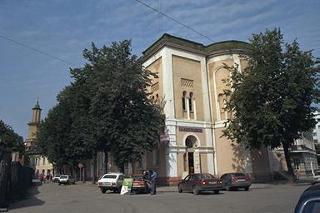
September
1997
|
| [Photo
source: S. R. Juni, Sept. 1997, copy
made from a photographic copy of a
pre-WWI antique postcard in a
collection created from various
private collectors. The collection
of copies is located at the Ivano
Frankivsk Historical Museum, located
on the ground floor of the Ratusha,
old city hall building in the center
of Rynek, the center town square.] |
Comments and observations about
The Great Synagogue building
by Susannah Juni
Obviously, the beautiful cupolas
were destroyed during WWII, yet
the building remains grand in
appearance. The ground floor
level, accessible from the arched
door to the left of the curve in
the front of the building, is now
a store. It was unclear to me as
to whether the store is leased
from the government, or if the
synagogue must rent out this space
in order to have enough income to
maintain the building. It’s well
worth going inside the store to
see the old detail on the
building. Probably, this was the
old social hall for the synagogue.
After the holocaust, the space was
used as a social club for a local
professional association, who had
restored the interior of this
floor. Subsequently, the space was
made into a store during Soviet
times, which remains to this day.
The store deals in furniture and
hardware.
Old pre-WWI photographs show
large beautiful pointed decorative
cones on the roof. These no longer
remain, but one can see where they
had been attached. The old front
of the building is across the
street from the town's
philharmonic theater hall. Anyone
trying to find the shul might do
better by asking people for the
location of the philharmonic
theater, as most residents do not
seem aware that there is a
synagogue.
The angle of the shot on the
right is slightly different from
the shot on the left, so you can
see Rynek, the center of the town
square (the pointed tower) in the
background. The picture on the
left shows two nearby buildings.
The building on the far left was
in the process of demolition
during my visit in September,
1997. Directly across the street
from the synagogue, notice the
columns on the corner of the
building on the right edge of the
pre-WWI picture. That building,
still existing and functioning, is
the Philharmonic Concert Hall,
built in the 1800s. A grand
location for a grand synagogue.
|
|
Stanisławów was a city with over
50 synagogues, ranging in size
from the large, elegant Great
Synagogue in the center of town
(shown above), to tiny shtibelekh,
some of which were merely the
living rooms of the homes of
neighborhood rebbis, which
functioned as places for a minyen
to pray, and to study. There is
one functioning synagogue today in
Ivano Frankivsk. One could say
that there is "only one;" and yet
one could say that it is a miracle
that there actually is a
functioning synagogue at this
time, over 50 years after the
virtual destruction of the entire
Jewish community. Keep in mind
that Stanisławów had a total
population of over 100,000
(perhaps over 150,000), with
25,000 to 30,000 or more Jews
prior to WWII. (Different sources
vary on exact figures depending on
the exact time period referenced
in history. We'll add a listing of
population statistics to this web
site in the future.)
The remaining synagogue is
indeed the original Great
Synagogue, pictured above. The
building was returned to the
Jewish community when Ukraine
seceded from the Soviet Union in
1991 upon petitioning to the local
authorities by Rabbi Kolesnik.
(Rabbi Kolesnik was born in Ivano
Frankivsk after WWII to Jewish
parents stemming from further east
in Russia. His parents, having
survived the Holocaust, were
resettled by the Soviet government
in Ivano Frankivsk. He has created
a functioning center of Jewish
identity by opening the doors of
the Great Synagogue for regular
services, all year round, despite
lack of heat (removed during the
Holocaust), and other necessities.
The original pews have been
replaced by folding chairs. Every
shabes, enough Jews come to make a
minyen, and services are held.
Every High Holiday, Jews come from
all of the surrounding towns and
villages to pray here. Reb
Kolesnik counts the synagogue
membership at over 300. A miracle;
a tragedy with an eternal flame of
hope and strength. (Note: Most,
but not all, of the 300 Jews
currently in the area did not
originate in this city, but were
resettled here by the Soviets from
further east in Russia at various
post-Holocaust times. Nonetheless,
they are Jews who are faithfully
holding our place in geographic
and cultural history. We depend on
them, and are grateful to them.)
In September, 1997, I had the
precious honor of praying in the
Great Synagogue, here in the city
of virtually all of my ancestors,
at a Sabbath service, and also at
a Rosh Khodesh service. I still
tremble when I ponder my cherished
memories in that place. Each
moment, during the services, while
meeting with the Rabbi in his
study, bending over my family
notes with some of the few Jewish
survivors who had actually lived
in Stanisławów before the war,
searching in vain for anyone who
might remember my then-large
family, the warmth of the women
who sat with me at the kidush
table after services, my tears
when we all sang familiar Yiddish
songs together in celebration of
the Sabbath, all of these moments
will forever resound in my heart
as a metaphoric echo of our
ancestors' voices.
View the photos below to join me
on a tour of this beautiful and
important building. May this
structure, and all of the events
that happen inside, from the
leadership of the kind heart and
soul of Rabbi Kolesnik, continue
to keep and hold the reality that
despite the vast efforts of our
enemies, our people will not
disappear from our home, our
spiritual home. As Jews have done
for thousands of years, we carry
this spiritual home deep inside
out souls, wherever we live; yet
this building and all that it
represents defiantly recall the
tens of thousands who dare to
never be forgotten. Barukh hashem.
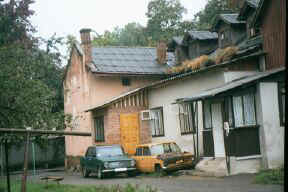
A former Talmud Torah study
house in Ivano Frankivsk
(Stanisławów).
[photo source: Joyce Field,
ShtetlSchleppers tour - September,
2000.]
|
The Great Synagogue Courtyard
Entrance
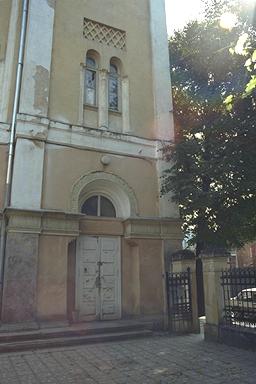
[photo source: S. R. Juni, Sept.
1997]
You enter the synagogue today,
through a gated courtyard entrance
in the rear. For walking
directions to the synagogue from
the Roxalana Hotel (now called the
Auscoprut Hotel, as of September,
2000) see the directions on the
right side of the page.
In the gated courtyard, where
one now enters the synagogue,
there is a tiny free standing
building (roughly the size of a
toll booth) that looks like it
might have once been a guard house
of some sort. In September, 1997,
it housed a jewelry repair shop.
Neither of the two businesses in
the synagogue property (this
jewelry repair shop or the
furniture shop in the front of the
building) are run by Jews or are
affiliated with the synagogue in
any way. Both seem highly
incongruous.
|
The Great Synagogue
How to Get There
[Source: From S. Juni's notes
after September, 1997 trip.]
Directions to the Great Synagogue
from the Hotel Roxolana (a five
minute walk):
Turn right from the hotel on
Grunwald Street.
Turn left on 3-go Maja Street
(old Polish street names - see
reference maps).
When you come to the new
Parliament building on the right
(huge curved white building), turn
right immediately past it.
There’s a cafe called “The Black
Cat” on this street across from
the Parliament building, written
only in Ukrainian, but you can see
the cat decals on the window.
Turn left at the first small
street.
Turn right at the next street.
It’s on the right, first building
on the corner. Enter through the
gated courtyard in the back of the
building. (The last two streets
are not labeled on any new or old
map we found, nor were signs
posted with the names of these
streets in any language.)
|
The Great Synagogue Interior
View from behind the current
mekhitse (the wall separating the
women's section)
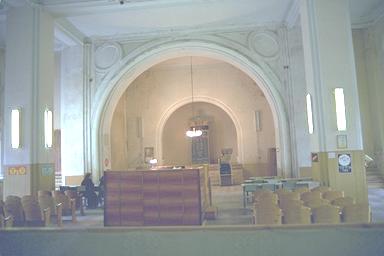
[photo source: S. R. Juni, Sept.
1997]
|
Inside from the courtyard entrance,
you go upstairs to enter at the back
of the main sanctuary. Facing the
bima, the Rebbe’s study is the room
straight ahead on the right, and the
Beys Midrash is on the left (views
in other pictures, below). They
still (or once again) hold Hebrew
classes a few times a week, with
about 12-15 adult students. The old
grandeur is still there, but it’s
sorely lacking for paint, heating,
and a wide range of basic upkeep
repairs. The ceilings are huge with
lots of fancy windows, curved at the
tops. Bits of broken decorative
detail remains here and there. The
center bima, for reading the torah,
is rebuilt, and there is a small
lectern at the front, near the new,
simple ark. The old women’s section,
upstairs in the back, is now used
for storage. The women still sit
separately, behind a small wall in
the back of the sanctuary, which you
can just see over if you stand up. A
few Jewish wall calendars and paper
Hebrew banners are tacked around.
They do not have a matching set of
prayer books. Rather, they use
whatever collection of donated
sidurim they can gather. Several
were donated by American
congregations when their
congregations updated to newer
editions. [See below for personal
notes from S. R. Juni, Sept. 1997 on
her visit to The Great Synagogue] |
|
 |
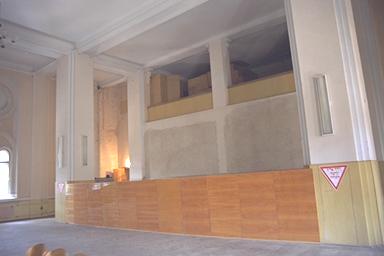 |
|
[photo source: S. R. Juni, Sept.
1997]
View on right showing the current
mekhitse (the lower wooden wall at
the left separating the women's
section) and the older original
mekhitse in the balcony at the
left. The wooden structure on the
left, in the center of the main
area, is where the rebbe reads the
Torah, a traditional European shul
layout.
|
Personal Memoirs: Davening
in Ivano Frankivsk
by Susannah R. Juni
LOCATION: Stanisle
(Ivano-Frankivsk) Sept., 1997 -
As spoken into a tape recorder
for my mother, Rachel Juni. [by
S.R. Juni]
We are in a café and I want to
leave my impressions right away.
We went to the synagogue on
Shabes. It was just incredible.
The service was very
traditional.You know the women are
separated from the men. Also, they
are very short of sidurim so they
really use whatever they have, all
mix matched - you know it was kind
of hard for me to follow along.
There was someone there who made
sure I had a sidur and who made
sure I had one that had both
English and Hebrew. In fact it was
a funny irony because the sidurim
they have are generally old ones
that people have donated from
synagogues from various places all
over the world. The one they gave
me was an old one from the
original Anshe Chesed synagogue
(in New York City). It is very
funny because of course, I belong
to Anshe Chesed now, but I belong
to the new Anshe Chesed (new
congregation, re-established in
the early 1970’s when the original
congregation was dwindling in
numbers) and this was an old one
from 1910 from the old Anshe
Chesed. (The new congregation was
started by Michael Strassfeld and
Paul Cowen and their families who
all had very progressive and
egalitarian ideals. As I looked at
this old sidur, the irony was
amazing.) It was very traditional.
It even had a blessing in the
book....I don't know if they said
it or not because I had trouble
finding my place because it wasn't
really following exactly the one
that I had or the one that anyone
had I think. It even had a very
old fashioned translation of a
traditional blessing for a man to
thank God that he wasn't made to
be a woman. An ultra, ultra humble
version for a woman thanking God
for making her from twigs of the
earth or something. [My apologies
to anyone reading this who feels
that these are important
traditional prayers. I do not
intend to be disrespectful; I'm
merely recording my personal
impressions, based on who I am.] I
was happy to be there. It felt
most meaningful.
I really enjoyed talking to you
last night mayn shayne mamale and
laughing about my reaction to the
women sitting separately from the
men. Anyway, it was a very serious
service. When I first arrived,
there were only about 16 men and
two other women besides myself.
The two women who were there were
probably in their 60s and they
were very serious about their own
type of praying. Then, later
towards the very end of the
service, about 8 or 10 more women
came. They just stood behind the
wall so they could see over it.
They didn't even bother to sit
down, so they could see. So, in
the end there were about 16 men
and about 11 women. (About four or
five of the men wore tefillin, the
traditional leather box with a
prayer inside and long complex
leather arm and head straps, an
ancient prayer ritual.)
Then afterwards I was invited to
go to kiddush (after services
buffet) by the Rabbi and also by a
couple of other people in the
synagogue. Really, hardly anyone
there speaks English at all. I had
arranged for Alex [Dunai, my guide
and translator] to come at 12:30 .
The Kiddush started at 12:00 so
the Rebbe and also two of the
women invited me to sit. It was a
separate table for women, and one
for men at the Kiddush. They had
boiled eggs and tomatoes cut into
wedges and cold white navy beans
and canned sardines, bottled
mineral water . Far makhn L'Khaim
zay hobn gehat vodke. (For making
a toast, they had vodka.) So that
was pretty unusual to me, since we
usually use wine in America. [Wine
is too expensive in Ukraine - and
kosher wine very hard to find.]
(Note from Ray Juni: Actually, in
my memory [in America - 1920s and
'30s], the Shabes kiddush usually
did have shnapps. For the fish, it
was usually herring. I am thinking
of the old Union Hall street
synagogue in Jamaica, Queens, but
I think this was customary at the
orthodox kiddush.) So, there was a
blessing over the wine which the
Rebbe did with the special goblet.
Then we all hobn gemakht L'Khaim
mit vodke ( then we all said the
blessing with vodka) So, we were
all sitting. There was a woman
sitting next to me who knew just a
few words of English. But, she did
not know any Yiddish. We were
trying to talk, but it was a
little difficult. In the middle of
trying to talk, suddenly from the
men's table they started singing.
They were singing a song about
about the Rebbe tantsn. I think it
was maybe Sha Shtil and I just
burst into tears. (Note from Ray
Juni: I used to sing this to you a
bit. My grandfather used to sing
it to the grandchildren, too. You
have heard it often on various
records that we have.) I just had
to apologize and I was trying to
explain that my grandparents knew
this song.
There was one woman there, a
couple of seats away, who knew
some Yiddish (Rosa) and she found
a little piece of napkin for me
because she could see that I
couldn't stop crying. They just
were singing lots and lots of
songs. I really wanted to turn on
the tape recorder but I think it
was kind of impossible . You know,
I didn't want to offend anyone
because it was Shabes. Lots of
songs, lots of pieces of Yiddish
songs and all of which I knew.
Also, Hebrew songs like Shomer
Shabes that Marilyn Krimm [a dear
family friend in America] used to
have us sing at the Beth Emeth
synagogue in Ann Arbor [Michigan].
She had us sing it a certain way
with clapping our hands. It was a
lot of fun. She said some people
didn't like to sing it quite in
such a fun way. Actually, that was
exactly how they sung it there
with the clapping on the knees and
whatever, "Shomrey, Shomrey,
Shomrey Shabes." It was
just so wonderful.
The Rabbe was calling out to me
and someone there, a man, you know
it was a small room, a men's
table, a women's table, but we
were all shouting back and forth
to each other. Alex came at 12:30
and he of course had to sit with
the men . He was wonderful.
Whenever possible, he was shouting
out translations for me from all
the little jokes and everything.
It was so wonderful. Someone was
teasing. There was one man, sort
of a big makher at the shul and he
was really getting into singing
some Yiddish songs. It was just
like a verse of each one and that
was it. The Rabbe would come in
with some [lovely] old Nigun
things. Someone was teasing him
and said "What makes you so happy
today?" He nodded towards me
futily trying to wipe away my
tears of joy, and said, Shoshana.
Because they could see how happy I
was and then they asked me how I
was feeling. Through Alex, I said,
"Well, I am crying, I am so happy.
I feel the souls of my
grandparents," and he translated
for them. They were smiling and
nodding and singing more songs. I
think they were really enjoying
seeing how moved I was. I really
was moved, indeed. I just wish you
could have been there and Jack [my
brother] and Pop and everybody. I
was just so much thinking of
Grandma and Grandpa. They kept
pouring me more vodka. It was very
funny. They kept giving me more
food. It was very nice. Anyway,
I'm thinking of you very much.
|
Photo information provided by:
Susannah Juni |
|
|
|


